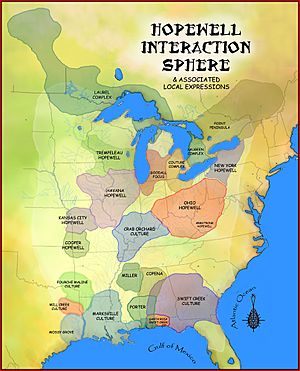Armstrong culture facts for kids
The Armstrong culture was a group of people who lived a long time ago, between the years 1 and 500 CE. They were part of the larger Hopewell culture. You could find them in the Big Sandy River Valley, which is in parts of northeastern Kentucky and western West Virginia.
Contents
Who Were the Armstrong People?
Scientists believe the Armstrong people were a special group within the bigger Hopewell culture. They might have also been a Middle Woodland group who were influenced by the Hopewell. These people lived peacefully alongside the local Adena groups.
An archaeologist named Dr. Edward McMichael thought the Armstrong culture was a trading group. He believed they brought Hopewell ideas to the area. They likely blended peacefully with the Adena people in the Kanawha River Valley. Over many years, the Armstrong culture slowly changed and became what we now call the Buck Garden people.
What Did the Armstrong People Make?
The Armstrong culture created many interesting things. They focused a lot on trading with other groups.
Armstrong Pottery
The Armstrong people were skilled at making clay pots. Their pottery often had a shiny, yellow-orange color. This color was similar to the pottery made by the late western Ohio Hopewell groups.
One type of their pottery was called Peters Cordmarked. This pottery had marks from cords pressed into the wet clay. It was very similar to McGraw Cordmarked pottery, which was made by the classic Ohio Hopewell people around 50 CE. This shows a connection between these different groups.
Homes and Burial Mounds
The Armstrong people spent most of their time on long-distance trade. They did not build huge structures like some other groups. Their villages were spread out and had small, round houses.
They also had a special way of burying their dead. They would cremate, or burn, the bodies. Then, they would place the remains in small burial mounds. These mounds were built in the Big Sandy Valley. Over time, they would add more layers of earth to these mounds, making them bigger.
The Armstrong people also made small flaked knives. They created special arrowheads called "corner notched points." These tools were made from a type of rock called Vanport chert. They found this chert in the greater Muskingum River valley area.
How Did They Get Food?
The Armstrong people grew some crops, much like the earlier Adena people. They mostly grew plants that climbed, like string beans. They also grew pumpkins and other types of squashes.
Besides these, they grew native grasses, tubers (like potatoes), bulbs, and gourds. An important crop called Maize (corn) was not grown by the Armstrong people. Corn became a main food for many Native American groups later on, but it did not reach this area until many centuries after the Armstrong culture.


